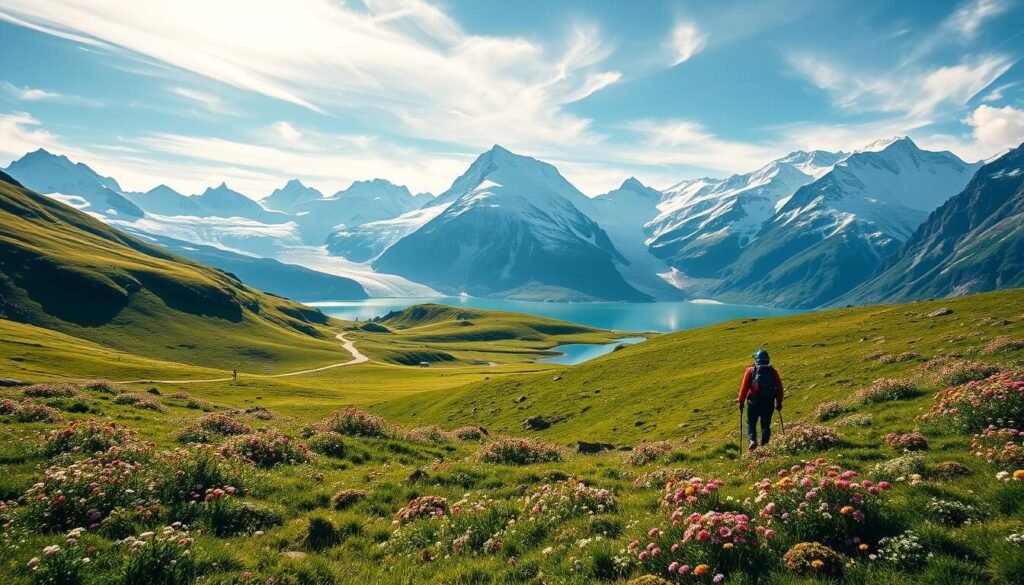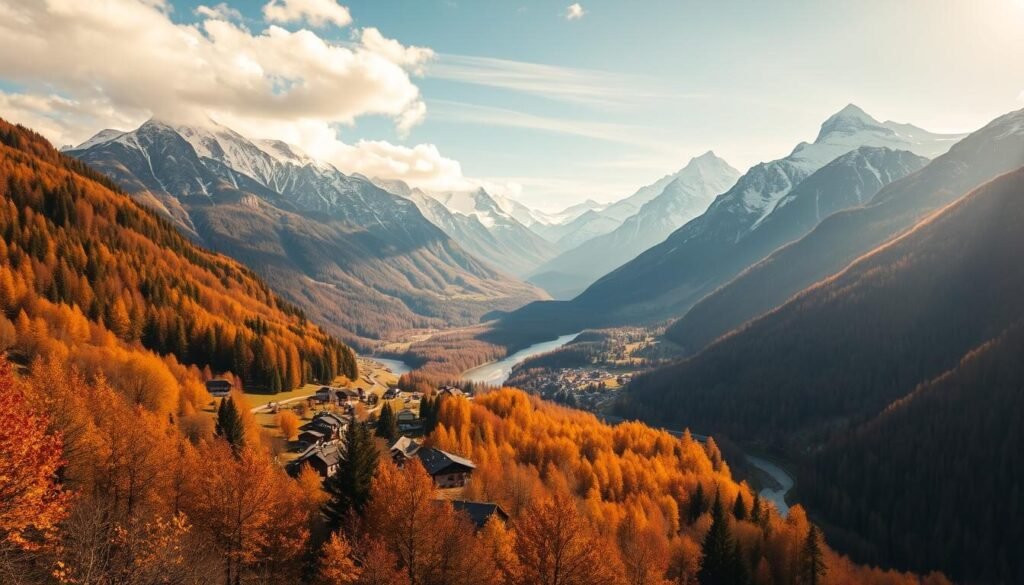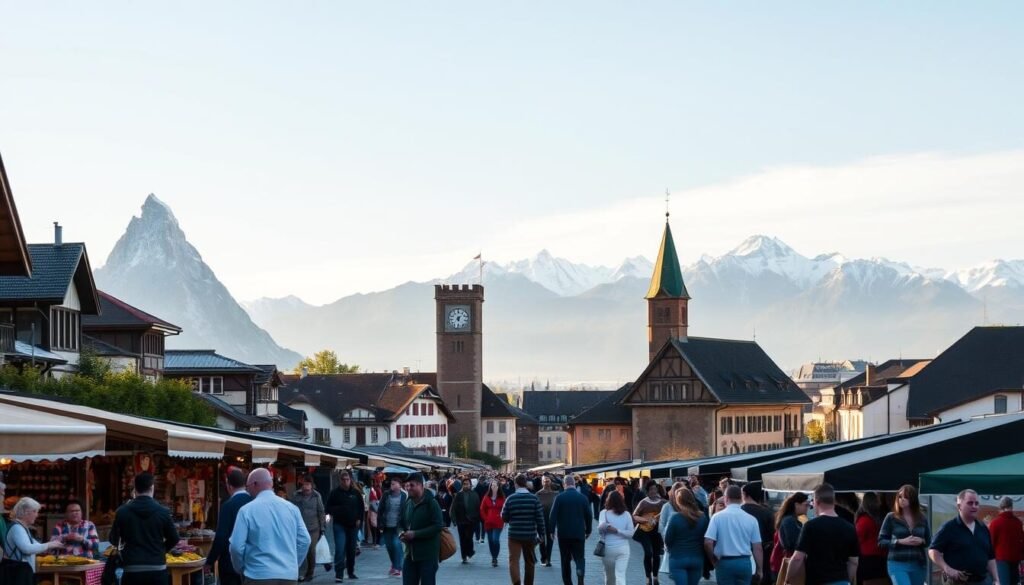Best Time to Visit Switzerland: The Month That Changes Everything Forever
Did you know Switzerland’s Alpine peaks attract over 12 million international visitors yearly? Yet fewer than 15% experience its full seasonal magic. This land of lakes and mountains transforms completely every few months, creating entirely different vacations depending on when you arrive.
Snow blankets ski slopes from December through March, while wildflowers explode across valleys come spring. Summer brings sunny lakeside festivals, and autumn paints vineyards gold. Each season unlocks unique adventures—whether carving fresh powder or hiking through fragrant meadows.
Your travel goals shape the ideal window. Love bustling energy? July’s warm days buzz with open-air concerts. Prefer quiet charm? May or September offer thinner crowds and lower prices. Even winter varies: December sparkles with Christmas markets, while February guarantees prime skiing.
Regional differences add surprises. You could ski Zermatt’s slopes and stroll palm-lined Lugano streets on the same March day. Timing affects everything—from hotel rates to which mountain passes stay open. Smart planning lets you craft trips matching your pace and passions perfectly.
Introduction to Switzerland’s Captivating Seasons
Switzerland’s secret? It never closes for the season. This compact country packs four distinct weather patterns into one unforgettable destination. You could ski powder-fresh slopes in the morning and picnic in flower-filled valleys by afternoon—all thanks to its dramatic elevation changes.
Nature’s Year-Round Playground
What makes these mountains a perennial favorite? Microclimates create parallel worlds across regions. While snow blankets Zermatt in March, palm trees sway in Lugano’s Mediterranean-like warmth. You’ll find heated trains whisking you between seasons, and cozy inns ready whether you’re escaping summer heat or winter chill.
| Season | Weather | Must-Try Activities |
|---|---|---|
| Spring | 45-65°F, blooming meadows | Alpine flower trails, cheese dairy tours |
| Summer | 68-77°F, low humidity | Lakeside festivals, Via Ferrata climbs |
| Autumn | 50-60°F, golden vineyards | Wine harvest feasts, forest photography |
| Winter | 20-35°F, reliable snowfall | Igloo hotels, night sledding |
Every Month Brings New Magic
Cultural rhythms sync with nature’s calendar. April brings Alpabzug parades as cows return to high pastures. September’s grape stomping festivals turn villages purple with juice. Even deep winter sparkles with lantern-lit Christmas markets and fondue feasts under starry skies.
Smart travelers match their passions to seasonal specialties. Prefer quiet trails? May’s melting snow reveals hidden waterfalls. Craving vibrant energy? July’s long days mean open-air concerts lasting past sunset. Your perfect Swiss story waits in every weather pattern.
Spring and Summer Adventures in Switzerland
Switzerland transforms into a kaleidoscope of color and energy between March and August. Crisp mornings give way to sun-drenched afternoons, with temperatures climbing from 41°F to 82°F. This dual-season window lets you chase wildflower blooms one day and dive into lakes the next.

Blooming Landscapes & Vibrant City Life
Spring paints valleys with crocuses and daffodils while snow lingers on peaks. Trails in the Jura Mountains burst with color, perfect for uncrowded hikes. Cities like Zurich buzz with events like Sechseläuten—a fiery snowman ritual marking winter’s end.
Lakes, Festivals, and Outdoor Escapades
Summer turns Lake Geneva into a playground for paddleboarding and sunset cruises. The Montreux Jazz Festival electrifies July nights, while August 1st fills skies with fireworks for Swiss National Day. Long daylight hours mean extra time for biking through Alpine meadows or swimming in Lake Thun’s turquoise waters.
Navigating Peak Season Like a Pro
Beat the crowds by booking hotels 6 months ahead for July-August trips. Hit trails at dawn for serene moments—even the Glacier Express feels magical at sunrise. For city stays, Lucerne’s lakeside promenades stay quieter than Zurich’s shopping districts.
Fall and Winter Charm: A Seasonal Journey
When leaves turn gold and snow crowns the peaks, Switzerland reveals its dual personality. Crisp air carries the scent of roasting chestnuts in cities, while mountain villages prepare for months of frosty fun. This seasonal shift creates two distinct ways to experience Alpine magic.

Autumn Splendor: Wine Harvests, Festivals, and Scenic Trails
September temperatures hover near 59°F—perfect for hiking through fiery larch forests. The Lavaux vineyards buzz with wine harvest celebrations, where you can stomp grapes beside Lake Geneva. Don’t miss the alpabzug processions: cows decked in flowers parade down valleys, their bells echoing like nature’s orchestra.
By November, mornings sparkle with frost as temperatures dip to 36°F. Trails like the Engadine Panorama Path offer Instagram-worthy views of snow-dusted peaks above golden valleys. Cozy mountain huts serve creamy raclette to warm chilly fingers.
Winter Wonderland: Ski Resorts, Christmas Markets, and Snowy Peaks
December transforms the Alps into a skiing paradise. Resorts like Verbier and St. Moritz open 300+ km of groomed slopes. Après-ski scenes buzz with fondue pots and spiced wine—Zermatt’s igloo bars even serve cocktails in ice glasses.
Lowland cities shine too. Zurich’s Christmas markets glow with hand-carved ornaments and gingerbread smells. For something wilder, St. Moritz hosts horse races on frozen lakes. Whether carving fresh powder or sipping glühwein, winter here feels straight from a storybook.
| Season | Avg Temp | Top Experience | Local Treat |
|---|---|---|---|
| Fall | 36-59°F | Lavaux wine festivals | Walnut cake |
| Winter | 28-39°F | Zermatt night skiing | Cheese fondue |
Exploring Swiss Cities and Cultural Experiences
Swiss cities blend historic charm with modern energy, offering cultural treasures that shift with the seasons. Spring brings quieter streets and blooming parks—ideal for discovering urban gems without summer crowds. You’ll uncover medieval bridges, avant-garde museums, and lakeside cafés where daily life unfolds against mountain views.

Urban Adventures in Zurich, Geneva, and Lucerne
Zurich’s Bahnhofstrasse dazzles with luxury boutiques, while Geneva’s Jet d’Eau fountain towers over Lake Léman. Lucerne steals hearts with its Chapel Bridge and frescoed buildings. These cities shine brightest in April-May when hotel rates dip and tulips frame waterfront promenades.
Local Festivals and Time-Honored Traditions
Plan around Zurich’s Sechseläuten in April—locals torch a snowman effigy to welcome spring. Lugano’s Autumn Festival fills piazzas with chestnut roasters in October, while Neuchâtel’s grape harvest events let you stomp fruit barefoot. Even small towns host lively markets selling hand-carved crafts and saffron-infused risotto.
Winter transforms villages into storybook scenes with steaming mugs of glühwein at Christmas markets. Whether you’re snapping photos of Bern’s Zytglogge clock tower or tasting fondue in Gruyères, Swiss cities deliver culture you can touch, taste, and hear in every season.
Outdoor Activities and Scenic Trails Across the Alps
Switzerland’s rugged beauty becomes your personal playground, offering activities that shift with the seasons. From flower-lined paths to snow-capped peaks, the Alps deliver endless ways to connect with nature. Let’s explore how to maximize your adventure across this iconic landscape.
Hiking, Biking, and Mountain Trekking Routes
Spring unlocks trails through the Jura Mountains and Pre-Alps, where melting snow reveals carpets of edelweiss. By summer, routes like the Via Alpina challenge hikers with panoramic views in the Bernese Oberland. Mountain bikers find bliss on single-track paths winding through Swiss National Park’s untouched valleys.
Lower elevation paths stay accessible year-round, while higher routes like the Eiger Trail require July-September timing. Pack layers—weather changes faster than a marmot’s sprint!
Skiing, Snowboarding, and Alpine Sports
When winter blankets the mountain ranges, legendary resorts come alive. Zermatt’s Matterhorn slopes cater to experts, while St. Moritz offers champagne powder for all skill levels. Modern lift systems whisk you to 10,000-foot peaks before lunchtime.
Try night sledding in Grindelwald or ice climbing in Saas-Fee. Après-ski culture shines brightest here—think fondue feasts paired with valley sunset views.
Scenic Train Journeys: Experiencing Switzerland by Rail
The Glacier Express redefines train travel with 8 hours of alpine wonder. Panoramic windows frame icy gorges and stone bridges between Zermatt and St. Moritz. For shorter rides, the Bernina Express climbs through UNESCO sites without spilling your hot chocolate.
Pro tip: Spring and fall rides mean fewer crowds and golden-hour lighting on lake reflections. Rail passes make hopping between trails and towns effortless.
Best Time to Visit Switzerland: Making the Season Count
Your Swiss adventure hinges on one choice: when to experience its ever-changing landscapes. While April through October draws most travelers, winter enthusiasts find snowy perfection from December to March. The secret? Match your priorities to the rhythm of the Alps.
Tailor Your Trip Based on Weather, Crowds, and Local Events
Love sunshine and festivals? June-August delivers lakeside concerts and hiking under endless blue skies. Prefer quiet trails and golden vineyards? September’s crisp air and harvest celebrations shine. For those craving snowy peaks, February offers prime skiing with fewer holiday crowds.
Shoulder months like May or October balance mild weather with value. You’ll stroll through blooming meadows or autumn forests without summer’s bustle. Planning your Swiss journey? Check Audley Travel’s seasonal guide for tailored insights.
Whether chasing wildflowers or carving fresh powder, Switzerland rewards thoughtful timing. Pack for layered outfits—mountain forecasts change fast. With 7-10 days, you’ll savor both iconic peaks and hidden valleys, crafting memories that outlast every season.





